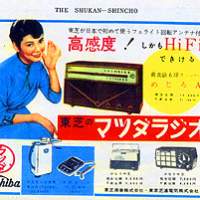Fifty years ago this week -- when Prime Minister Ichiro Hatoyama was reopening diplomatic relations with Moscow; bullet trains or expressways had yet to be built; and a bank staffer's monthly pay was about 25,000 yen -- Tokyo publisher Shinchosha launched the weekly Shukan Shincho, priced at 30 yen. Its appearance marked the first time that a publisher of bungei-sho (literary and arts books) entered the weekly magazine market -- and it set off a boom.
A replica of that 82-page first edition, feting Shukan Shincho's 50th anniversary, went on sale Feb. 16, its cover bearing an illustration titled "Kazusa no Machi (A Town in Central Chiba)" by Rokuro Taniuchi, a beloved fixture who produced another 1,302 front-cover illustrations prior to his death in January 1981.
Older readers will immediately recognize other still-regular features, including glossy gurabia (gravure) photographs at the front and back.
"Running outstanding photos by talented cameramen, which eloquently expressed the aura of the times, was one of our trademarks from the beginning," remarked Editor Kiyoshi Fukushima, a 28-year veteran of the company.
In addition to critiques on cinema, art, drama, music and books, articles in that first issue took up aspects of Japan's still-ongoing debate over its Constitution, which in 1956 was approaching its 10th year. Another article considered the prospects for technology enabling doctors to determine the gender of a human fetus; while in another a young married woman discussed the travails of part-time employment. All pretty mundane stuff.
So when did magazine coverage shift to the kind of political scandals, lurid celebrity gossip and shocking crimes for which Japan's weeklies are now famed -- or infamous?
"That was much more recently, like five or 10 years ago," said Fukushima. "Our contents began changing because the newspapers and other media weren't reporting those kind of things."
Sadly missing
One thing purchasers of this week's commemorative 300 yen edition will sadly not be able to enjoy are the fascinating adverts that appeared 50 years ago. These include ones for a camera with bellows-type lens extension, a "hi-fi" table radio using vacuum tubes, a washing machine featuring a manual wringer -- and a Mikimoto pearl necklace for an unbelievably cheap 6,000 yen. Clearly, in 1956 Japan's world-renowned flair for generating innovative and exciting consumer goods was still a thing of the future.
Indeed, a short item on page 23, titled "Kokuminsha ni kitai suru (Expectations toward a people's car)," shows that this even extended to cars -- an industry in which Japan is now top dog.
According to the article, to emulate Germany's Volkswagen, which was making a major contribution to West Germany's postwar economic recovery, the Ministry of International Trade and Industry in Tokyo envisaged a similar vehicle for Japan. This so-called kokumin-sha (people's car) would be a four-seater capable of cruising at 100 kph, and selling for under 250,000 yen (around $700 at then-current rates).
However, the Japan Automobile Manufacturers Association noted that a prototype being built at Toyota's Koromo Plant in Aichi Prefecture would sell for around 450,000 yen. And it sagaciously sucked air in through its teeth, declaring: "Unless supply and demand could be balanced, the price would not go down; but [the maker] is caught on the horns of a dilemma, since demand would need to be boosted before mass production could begin."
And besides, the same article noted, even 350,000 yen was far beyond the means of most workers, for whom it was more than a years' pay. "With the poor quality of Japan-made goods, [such a car] is merely 'barley' for people too poor to afford white rice," it continued. "And even if a 'people's car' does get produced, it seems likely to spawn the peculiar phenomenon by which influential people continue riding in expensive imports."
Who could have foreseen, from a look at Shukan Shincho in Feb. 1956, what Japan would be like 50 years later?


















With your current subscription plan you can comment on stories. However, before writing your first comment, please create a display name in the Profile section of your subscriber account page.